This video is sponsored by Skillshare – the first 1000 people to use this link will get a 2 month free trial of Skillshare Premium Membership.
It’s that time again… SPF mythbusting time! Because no matter how hard I try, more of them turn up. (I did a video on SPF myths last year – check that out as well if you haven’t already.)

Video is here on YouTube, scroll down for the written version!
Myth 1: Chemical and physical sunscreens work in different ways
I feel like I talk about this a lot, but it’s a myth that won’t die and I see so many authoritative people repeating this myth on really big platforms, so here we go again!
You’ve probably seen this myth:
- Physical sunscreen basically acts like a shield or barrier that sits on the surface of your skin and reflects and scatters UV away
- Chemical sunscreens absorb UV and convert it to heat
It often comes with diagrams like this, which make physical sunscreens look much better than chemical sunscreens:
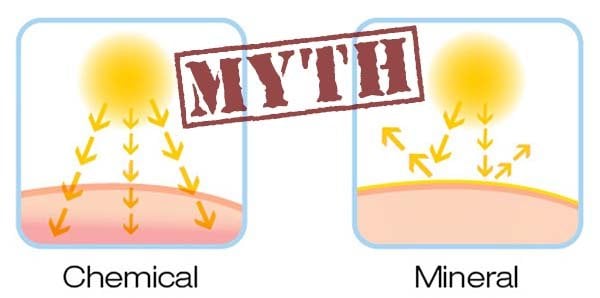
In fact, both physical and chemical sunscreens – or more correctly inorganic and organic sunscreens – mostly work by absorbing UV and converting it to heat. The real picture is more like this:
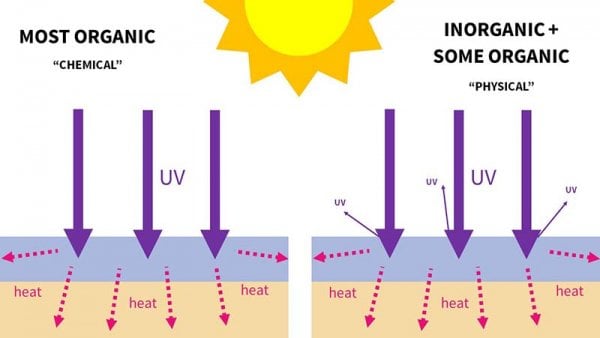
Chemical and physical sunscreens both mostly absorb UV and turn it into heat, but physical sunscreens scatter and reflect a really small amount – around 10% of incoming UV over the range of UV wavelengths. But this is only 10%, so it isn’t the main reason why physical sunscreens can be used as sunscreens: it’s mostly because they can absorb UV and convert it to heat, just like chemical sunscreens.
Related post: Chemical vs Physical Sunscreens: The Science (with video)
The technical details: both types of sunscreens have electrons that can be excited to higher energy levels by UV, then when the electrons relax back down they release the energy in different ways, mostly heat (I might go into this in more detail in a future post if people are interested!).
There’s also an organic or chemical sunscreen that works just like zinc oxide and titanium dioxide: methylene bis-benzotriazolyl tetramethylbutylphenol, also known as Tinosorb M. It’s an organic sunscreen, which means it’s carbon based, with a structure that looks like a lot of other organic or chemical sunscreens:
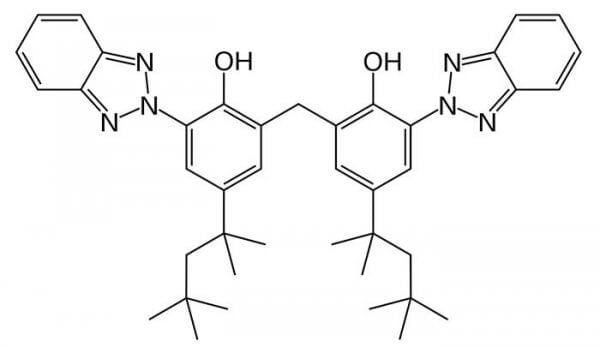
But it doesn’t dissolve in oil or water, so it’s incorporated into sunscreens as suspended particles. That means it also reflects and scatters some of the incoming radiation so in terms of how it works, it’s closer to zinc oxide and titanium dioxide even though it has a scarier name… but they’re pretty darn close to the organic sunscreens anyway so it isn’t a very useful distinction to make.

Once you understand that chemical and physical sunscreens work pretty much the same way, you’ll see why related myths are also wrong.
The most common one I’ve seen is that physical sunscreens are better for melasma and hyperpigmentation. This is based on the idea that heat makes melasma worse (another concept that’s pretty overblown). But if there’s only a tiny difference in the heat produced by physical and chemical sunscreens, then this isn’t a good reason to use one over the other, especially since the amount of heat produced is so small.
Then why does your skin feel hot under the sun when you’re wearing sunscreen? It’s mostly because… you’re under the sun. The sunlight that reaches your skin is roughly 42% visible light, 55% infrared radiation (IR), and 3% ultraviolet (UV) radiation – there’s a lot of heat around without the tiny contribution from UV being converted to heat by your sunscreen.
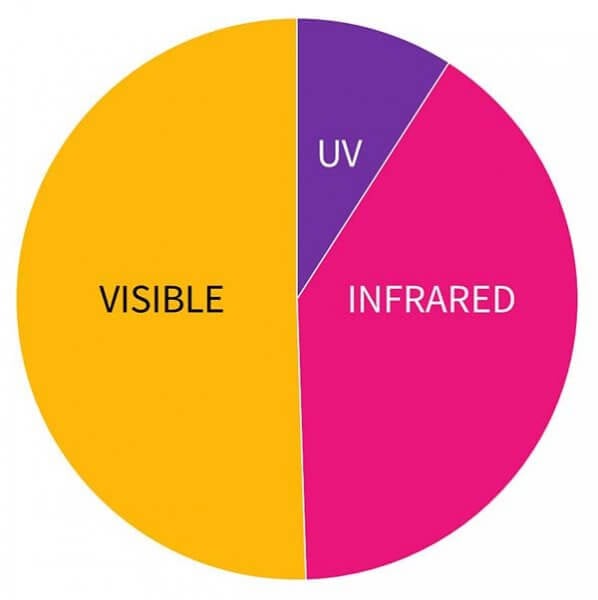
The big problem with people picking physical sunscreen over chemical sunscreen for the heat reason is that chemical sunscreens are actually awesome for hyperpigmentation! Chemical sunscreens can give much higher UVA protection, particularly with the newer UVA filters – all of the sunscreens with really high UVA protection factors use organic filters to get there, including:
Chemical sunscreens also give less white cast. This is important because people with hyperpigmentation usually have darker skin, so the white cast is a bigger problem… and the thing people usually do to avoid white cast is use less sunscreen, which is bad and leads to more hyperpigmentation.
Related post: Zinc Sunscreen Review and White Cast Comparison: Neutrogena, Invisible Zinc, SunSense
That said, some of the older filters can be a bit more irritating and some people are allergic to them. But other things in both chemical and physical sunscreens can also be irritating, and newer chemical sunscreens have extremely low irritation and allergenic potential (they’re designed to not go through your skin).
Related: The Lab Muffin Guide to Basic Skincare – Free Sample on Sunscreens
Myth 2: A little goes a long way with sunscreens
I see this all the time in reviews! Sunscreens end up getting a good review even though they’re expensive, because “a little bit goes a long way”.
If you’re a regular here your reaction is probably
*sharp intake of breath*
Sunscreen is the worst product to skimp on!
The amount of protection you get depends on the amount you apply. That’s because the chance of UV hitting a sunscreen particle is lower if you have less sunscreen particles on your face.
To get the labelled SPF, you need to apply 2 mg/cm2. This translates to around ¼ tsp for your face. UV protection generally decreases linearly, which means that using half the amount of sunscreen results in getting half the labelled protection.
Related post: How SPF Changes With How Much Sunscreen You Use
You can think of sunscreen like a foundation – you’re basically applying foundation to hide your face from the sun. Less sunscreen means you’re more likely to have patchy coverage, while more sunscreen means it’s easier to get an even layer.
Myth 3: We don’t need sunscreen because we evolved to live with the sun
There are two big things wrong with this idea:
1. We don’t live where we evolved
Thanks to mass migration, many of us live in places where people of our skin colour didn’t traditionally live (Australians and Americans come to mind).
2. Even in places where your skin colour historically evolved, there are different conditions today
Firstly, people didn’t go on beach holidays where they lay in the sun for hours thousands of years ago. Intermittent intense UV, like getting sunburnt on holiday, is linked to deadlier skin cancers like melanoma. The incidence of melanoma has steadily increased over the last 50 years – in Norway, for example, there was 11 times more melanoma in 2019 than in 1953. People also like tanning a lot more these days, since a tan is seen as attractive and healthy.
Environmental conditions are also different. One big change is the amount of ozone, which has an interesting story behind it.
Thomas Midgely Jr, the unluckiest scientist alive (he’s often rated the most destructive human being who’s ever lived) invented CFCs in the 1920s. These are super stable, non-toxic chemicals that are really useful in fridges, air conditioners and aerosols – you can breathe it and drink it without much fuss.
Unfortunately, because they’re so stable, they slowly diffused into the stratosphere. Once they made their way around 25 km above the Earth’s surface, they met the ozone layer. This layer, though thin, is vitally important for absorbing UV before it can hit the Earth.
And, unfortunately, CFCs are very good at catalytically destroying ozone. A drastically thinned area of the ozone layer (the ozone hole) was discovered above the South Pole in the 1980s, and in 1987 the Montreal Protocol was enacted to phase out CFCs and halt ozone destruction.
But the damage is still healing, and there’s less ozone around, which means higher UV levels. This is especially the case around the Antarctic ozone hole, which affects parts of Australia, New Zealand, Chile, Argentina, and South Africa.
(Thomas Midgley Jr also invented leaded petrol.)
We didn’t evolve with mass migration, beach holidays or thinned ozone – we need sunscreen.
Myth 4: Sunscreens cause coral reef bleaching
There is no good evidence that this is happening.
Where this idea comes from is misinterpretation of research, governments jumping on this to avoid dealing with bigger issues, and skincare companies jumping on this as a marketing opportunity to sell their “reef-safe” sunscreens.
And this isn’t just something that people who like sunscreen are saying – this is something that coral scientists who have been studying coral their whole lives are saying.
I quoted some of them in my earlier post on sunscreen and coral reefs – here are some quotes from a more recent opinion piece from two coral researchers, including the lead researcher for a recent study that measured sunscreen concentrations in Hawaii. I recommend reading the opinion piece – it’s a really good summary of the whole coral and sunscreen topic.
“We’re perplexed by the misguided distraction that a limited and unreplicated study about one of the sunscreen chemicals (oxybenzone) is gaining, and we’re frustrated that it’s taking the spotlight off scientifically proven concerns to reef decline. People are being led to believe there is extensive scientific evidence about the impact of oxybenzone on corals, and this is simply not true.”
A bunch of studies put corals in high concentrations of sunscreen ingredients, and they bleached.
But you need a high enough concentration to have a negative effect – this is called the dose makes the poison. If you eat 2 atoms of arsenic nothing will happen to you. So unless coral is getting a high enough concentration of sunscreen, it won’t be affected.
Scientists have been measuring the concentrations of sunscreens in the ocean around coral reefs to see if this should be a concern – and they’ve consistently found (aside from in one study – that result is contested and unreplicated) that the concentrations are too low to have the negative effects found in the studies. Since my last video on why sunscreen isn’t killing coral, there’s been more studies measuring sunscreen chemicals in nature, particularly around Hawaii, and the concentrations are still too low.
“Currently, the limited scientific evidence for Hawaii and Florida does not show that sunscreen chemical components exist at concentrations that harm corals.”
There’s also no real world evidence of sunscreen harming coral.
“If sunscreen were a cause of coral die-offs, we would expect to see reef damage where sunscreen concentrations are highest, but there is no data to support that.
In fact, the Australian government found the majority of recent coral bleaching occurred where there is low to no human interaction and that coral is actually healthier in tourist-heavy, high-traffic areas.”
The only direct published peer-reviewed evidence for coral reef being damaged by sunscreens is a comment by researchers who said they saw people swimming in areas with the worst coral damage. The issue with this is that anecdotal evidence isn’t good evidence. There are a million other things that could explain why coral where people tend to go is more damaged – people might trample them, people might choose to go there because it’s close to civilisation, which also means that sewage is probably coming out near there, etc. That’s why we need studies to show us there’s a likely link between coral bleaching and sunscreen… and that just hasn’t been happening.
The biggest factors contributing to coral reef damage according to coral scientists are climate change, biological imbalances from things like overfishing, and runoff from land-based pollution. There’s loads of evidence for this – studies in labs, studies in the wild – not just a couple of lab studies.
Then why are places like Hawaii focusing on the thing with the flimsiest evidence, and not what coral scientists have been pointing out for decades?
It’s because government policy isn’t always based on science (there are a ton of examples of this, like the war on drugs, the ban on vaping, the choice to give Australians bad internet…).
But climate change, biological imbalances and pollution are difficult problems for governments to fix. There are huge industry interests at stake there.
And on an individual level, for a lot of areas with coral reefs, tourism is a huge source of income – their government is going to avoid telling you that you shouldn’t fly there. It’s much easier to tell people the convenient lie that it’s fine to fly to coral reefs, as long as you wear the right sunscreen… even though air travel is one of the biggest contributors to your environmental footprint. And as a consumer, this is a really nice idea too, which skincare companies are of course going to take advantage of.
“While it’s enticing to think that an urgent problem like coral reef decline could be impacted by something as easy as choosing a different sunscreen, the reality is not so simple.”
If you want to play it safe, then maybe avoid using sunscreens with ingredients that have been found to harm coral (including some mineral sunscreens!) if you’re planning to swim right next to coral. But whether your sunscreen is “reef-safe” isn’t an important consideration when you’re choosing a sunscreen for everyday life, when the sunscreen will be massively diluted by the time it reaches any coral anyway.
If you want to do something much more meaningful to save coral reefs, the coral scientists suggest this:
“Instead of purchasing a “reef safe” sunscreen (a marketing claim that is not regulated by the Federal Trade Commission), consumers can eliminate their use of fertilizers. Government leaders can push for better wastewater solutions and invest in renewable energy, in addition to funding environmental research, protection and restoration.
Energy spent trying to enact ineffectual solutions may be well intentioned, but it’s wasted— and damaging. Let’s not waste more time and money fighting the right problem with the wrong solution.”
Related post: Is Your Sunscreen Killing Coral Reefs? The Science (with Video)
Myth 5: Moisturiser with SPF doesn’t work as well as sunscreen
The words “sunscreen” and “moisturiser” don’t really have different meanings when it comes to SPF protection. Both types of products are tested with the same methods, provided that they have the same regulated labels:
- SPF
- UVA rating (broad spectrum, PA, PPD, UVA logo, Boots star rating)
- Water resistance
There’s also additional regulatory requirements as well, depending on where you are in the world:
- In Australia, both products are regulated as listed therapeutic goods, so they’ll have an AUST L number
- In the US they’re regulated as drugs, so they have a Drug Facts label
The name “sunscreen” or “moisturiser” is just a marketing choice, and sunscreens that aren’t branded as moisturisers usually contain moisturising ingredients too.
Some people say it’s easier to apply the right amount of sunscreen compared to a moisturiser, but I disagree – from the sunscreens and SPF moisturisers I’ve tried, I don’t think there’s been a consistent trend.

There is a study that found that participants applied less of an SPF moisturiser than a sunscreen. They only tested one single moisturiser and one single sunscreen, but the study is misleadingly called “Application of SPF moisturisers is inferior to sunscreens in coverage of facial and eyelid regions”. I don’t think the study actually shows that (it would be more correctly titled “Application of AN SPF moisturiser is inferior to A sunscreen in coverage of facial and eyelid regions”).
Myth 6: You need to avoid alcohol in sunscreens
Alcohol is an ingredient that has a lot of myths around it: that it’s pro-aging and inflammatory, that it dries out your skin, that it’s irritating.
I talked about alcohol in skincare in my collaboration with Kind of Stephen. We looked at clinical studies where really high concentrations of alcohol (60-80%) were repeatedly applied on skin 2 to 100 times a day. They found that even with these really extreme conditions, there wasn’t a significant amount of inflammation or irritation.
Even for skin dehydration there were mixed results – skin wasn’t always less hydrated after being treated with tons of alcohol compared with the same amount of water.
With sunscreens, you probably only have 5-10% alcohol, and you probably don’t apply it anywhere near 20 times a day, so you’d expect that there wouldn’t be a lot of inflammation or irritation either. With dryness, another study on isopropyl alcohol (more drying than the usual ethyl alcohol in skincare) found that having humectants in the product made up for the drying effect of the alcohol.
So if there’s a sunscreen you love, and the only thing holding you back is seeing the word “alcohol” on the label, then it’s probably fine to keep using it!
Related post: How Bad Is Alcohol in Skincare, Really? The Science (video with KindofStephen)
(This video is here thanks to Skillshare – if you like educational videos like mine but with better production quality, it’s definitely worth checking out. Click here to get a free 2 month premium membership!)
References
Many of these myths have been covered before in previous blog posts and videos – refer to those for more details and references.
Mitchelmore C & Fenner D, Data doesn’t back sunscreen bans to protect coral reefs, Florida Today, Jul 1 2019.
Mitchelmore CL et al., Occurrence and distribution of UV-filters and other anthropogenic contaminants in coastal surface water, sediment, and coral tissue from Hawaii (open access), Sci Total Environ 2019, 670, 398-410. DOI: 10.1016/j.scitotenv.2019.03.034
Cole C et al., Metal oxide sunscreens protect skin by absorption, not by reflection or scattering, Photodermatol Photoimmunol Photomed. 2016, 32, 5-10. DOI: 10.1111/phpp.12214
Parker ER, The influence of climate change on skin cancer incidence – A review of the evidence (open access), Int J Women’s Dermatol 2020, in press. DOI: 10.1016/j.ijwd.2020.07.003
This post is sponsored by Skillshare; however, the content is all based on my independent research and my honest experience. This post also contains affiliate links – if you decide to click through and support Lab Muffin financially (at no additional cost to you), thank you! For more information, see Disclosure Policy.


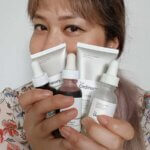
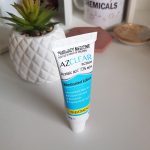


I always wondered about the claim that my SPF XX moisturizer wasn’t enough “because you don’t apply enough”. Um, yes I do. I apply lots. Some days I use a “sunscreen” as my moisturizer. Other days I use my moisturizer but I want a higher SPF (e.g. one of my moisturizers is only SPF 15) so I add one on top.
Thank you for this. The sunscreen-reef debacle was causing me major anxiety when it came to using sunscreens at the beach and in general. Thank you, thank you. I feel like a weight has been lifted off of me: I no longer have to anxiously decide between my skin’s health and nature’s health in this situation.
Thank you Michelle, for once again producing a cogent and coherent blog to the misconceptions out there. I roll my eyes every time I get into an argument about SPF and chemical/organic vs mineral/inorganic. Finally, I can send them a link that’s written by a scientist and is evidence-based. I live next to the Great Barrier Reef and it has always bewildered me why there’s such a big to-do about ‘reef-safe’ sunscreen and the dubious connection to coral bleaching. Now, I value the reef as much as anyone else, but I never could understand the sense in the hysteria around sunscreens when, as you so rightly point out, the flights here cause more environmental harm than the two teaspoons of SPF used. Please keep up your fine work.
Ok, I did well on knowing everything except that “reef safe” sunscreens weren’t needed because there is no proof that any sunscreen damages reefs.
But, unless I missed it, I didn’t read anything about avoiding nano particles or that some chemicals were linked to cancer. Being outside a great deal I put on enough sunscreen to think about it. Also, I would think those with young children would want to be extra careful because we have enough environmental stressors that are cumulative and removing as many as possible would be important even if there is only the tiniest possibility that problems would arise later in life.
I’ve talked about the health effects of sunscreen in a previous sunscreen myths post!
thank you for your response, I’ll check out your archives!
I really appreciate this. I came from a family of super “natural” hippies who constantly disparaged all “chemicals” including sunscreens. I was so scared I would get cancer simply by using sunscreen. Luckily I learned more about science and how chemicals work to realize that they weren’t right. My skin is so much happier using “unnatural” products like sunscreen. Your clear explanations are helpful for countering their fear mongering. Thank you!
I really appreciate this. I came from a family of super “natural” hippies who constantly disparaged all “chemicals” including sunscreens. I was so scared I would get cancer simply by using sunscreen. Luckily I learned more about science and how chemicals work to realize that they weren’t right. My skin is so much happier using “unnatural” products like sunscreen. Your clear explanations are helpful for countering their fear mongering. Thank you!
I force myself to wear more sunscreen than I wear moisturizer (or makeup), but I agree, the texture in both is usually similar, so it is more of a psychological thing I guess.
Not something I am explicitly searching for but glad I found 😉
That is a very interesting explanation and I am interesting to know more technical detail about the sunblocking particularly based on the fact that ZnO and TiO2 have the bandgap in the range of UV so does Tinosorb M. Could any other material with similar features with excitation energy in UV range will work?
Theoretically yes – the issue is usually their absorptivity i.e. how much you need to add to a sunscreen to get SPF 50. ZnO has awful absorptivity!
Hi Michelle thank you for the great content! I was wondering , if inorganic sunscreens scatter only 10 percent, why do they look so drastically different/ white on a UV camera? For example in this IGTV insta post by a cosmetic formulator https://www.instagram.com/p/CFSLpc7H3Qf/?utm_source=ig_web_copy_link
She put an organic sunscreen on part of her face and an inorganic one (Jason Mineral Sunscreen) on the rest. The two look completely different .. there is no dark component to the mineral sunscreen, it looks almost completely white/ reflectey.
I actually have a meeting with a UV camera company sometime soon, I’m going to be asking them about that! I suspect it’s to do with the wavelengths they use for detection – I’m guessing it happens to be a longer wavelength of UVA where more reflection happens.
Hi,did you have the meeting yet? Thanks!
I usually check EWG, Environmental Working Group, and they say Chemical sunscreens do get absorbed into the skin. So who’s right?
The Environmental Working Group isn’t a scientific organisation – they’ve been criticised by a lot of scientists for being fearmongering and anti-science. Here’s one article on them: https://www.forbes.com/sites/kavinsenapathy/2016/07/12/would-you-rather-buy-organic-or-poison-your-family-ewg-wants-you-to-pick-one/
It might seem counterintuitive, but standard math principles don’t apply when it comes to SPF numbers. “An SPF 15 blocks 94 percent of UVB rays, while an SPF 30 blocks 97 percent,” explains Dr. Zeichner. The increase in protection once you go above an SPF 30 is only incremental, so in this case, the highest SPF sunscreen isn’t necessarily the best.
He’s incorrect, that’s a long-running myth in dermatology circles. I busted that myth in the previous SPF myths post: https://labmuffin.com/top-7-sunscreen-myths-video/
I’ve heard some people said moisturiser+sunscreen combo is less desirable because it is often more expensive than using both separately since moisturiser is not to be reapplied as much as sunscreen is that true?